Animal Movement Prediction Based on Predictive Recurrent Neural Network
Abstract
1. Introduction
2. Related Works
3. Methods
3.1. Dataset
3.2. Movement Interpolation
3.3. Movement Density Sequence Generation
3.4. Movement Prediction
3.5. Model Construction
4. Experiments
4.1. Experiment Designs
4.2. Random Forest Interpolation
4.3. Movement Prediction
5. Conclusions
Author Contributions
Funding
Conflicts of Interest
References
- Morales, J.M.; Moorcroft, P.R.; Matthiopoulos, J.; Frair, J.L.; Kie, J.G.; Powell, R.A.; Merrill, E.H.; Haydon, D.T. Building the bridge between animal movement and population dynamics. Philos. Trans. R. Soc. B 2010, 365, 2289–2301. [Google Scholar] [CrossRef] [PubMed]
- Valletta, J.J.; Torney, C.; Kings, M.; Thornton, A.; Madden, J. Applications of Machine Learning in Animal Behaviour Studies. Anim. Behav. 2017, 124, 203–220. [Google Scholar] [CrossRef]
- Van Meerbeek, K.; Ottoy, S.; de Andrés García, M.; Muys, B.; Hermy, M. The bioenergy potential of Natura 2000—A synergy between climate change mitigation and biodiversity protection. Front. Ecol. Environ. 2016, 14, 473–478. [Google Scholar] [CrossRef]
- Van Moorter, B.; Rolandsen, C.M.; Basille, M.; Gaillard, J.M. Movement is the glue connecting home ranges and habitat selection. J. Anim. Ecol. 2016, 85, 21–31. [Google Scholar] [CrossRef] [PubMed]
- Tremblay, Y.; Robinson, P.W.; Costa, D.P. A parsimonious approach to modeling animal movement data. PLoS ONE 2009, 4, e4711. [Google Scholar] [CrossRef] [PubMed]
- Kranstauber, B.; Cameron, A.; Weinzerl, R.; Fountain, T.; Tilak, S.; Wikelski, M.; Kays, R. The Movebank data model for animal tracking. Environ. Model. Softw. 2011, 26, 834–835. [Google Scholar] [CrossRef]
- Kays, R.; Crofoot, M.C.; Jetz, W.; Wikelski, M. Terrestrial animal tracking as an eye on life and planet. Science 2015, 348, aaa2478. [Google Scholar] [CrossRef]
- Dragon, A.C.; Bar-Hen, A.; Monestiez, P.; Guinet, C. Comparative analysis of methods for inferring successful foraging areas from Argos and GPS tracking data. Mar. Ecol. Prog. Ser. 2012, 452, 253–267. [Google Scholar] [CrossRef][Green Version]
- Thiebot, J.B.; Pinaud, D. Quantitative method to estimate species habitat use from light-based geolocation data. Endanger. Species Res. 2010, 10, 341–353. [Google Scholar] [CrossRef]
- Rahman, N.M.F.; Baten, M.A. Forecasting area and production of black gram pulse in Bangladesh using ARIMA models. Pak. J. Agric. Sci. 2016, 53, 759–765. [Google Scholar] [CrossRef]
- Knudsen, E.; Lindén, A.; Ergon, T.; Jonzén, N.; Vik, J.O.; Knape, J.; Røer, J.E.; Stenseth, N.C. Characterizing bird migration phenology using data from standardized monitoring at bird observatories. Clim. Res. 2007, 35, 59–77. [Google Scholar] [CrossRef]
- Bildstein, K.L.; Mandel, J.T.; Barber, D.R.; Houston, C.S.; Bohrer, G.; Winkler, D.W. Migration path annotation: Cross-continental study of migration-flight response to environmental conditions. Ecol. Appl. 2011, 21, 2258–2268. [Google Scholar] [CrossRef]
- Patterson, T.A.; Thomas, L.; Wilcox, C.; Ovaskainen, O.; Matthiopoulos, J. State-space models of individual animal movement. Trends Ecol. Evol. 2008, 23, 87–94. [Google Scholar] [CrossRef] [PubMed]
- Michelot, T.; Langrock, R.; Patterson, T.A. MoveHMM: An R package for the statistical modelling of animal movement data using hidden Markov models. Methods Ecol. Evol. 2016, 7, 1308–1315. [Google Scholar] [CrossRef]
- Hirakawa, T.; Yamashita, T.; Tamaki, T.; Fujiyoshi, H.; Umezu, Y.; Takeuchi, I.; Matsumoto, S.; Yoda, K. Can AI predict animal movements? Filling gaps in animal trajectories using inverse reinforcement learning. Ecosphere 2018, 9. [Google Scholar] [CrossRef]
- Xu, Z.; Cheng, X.E. Zebrafish tracking using convolutional neural networks. Sci. Rep. 2017, 7, 1–11. [Google Scholar] [CrossRef]
- Browning, E.; Bolton, M.; Owen, E.; Shoji, A.; Guilford, T.; Freeman, R. Predicting animal behaviour using deep learning: GPS data alone accurately predict diving in seabirds. Methods Ecol. Evol. 2018, 9, 681–692. [Google Scholar] [CrossRef]
- Jonsen, I.D.; Myers, R.A.; Flemming, J.M. Meta-Analysis of Animal Movement Using State-Space Models. Ecology 2003, 84, 3055–3063. [Google Scholar] [CrossRef]
- De Groeve, J.; Van de Weghe, N.; Ranc, N.; Neutens, T.; Ometto, L.; Rota-Stabelli, O.; Cagnacci, F. Extracting Spatio-Temporal Patterns in Animal Trajectories: An Ecological Application of Sequence Analysis Methods. Methods Ecol. Evol. 2016, 7, 369–379. [Google Scholar] [CrossRef]
- Spiegel, O.; Leu, S.T.; Bull, C.M.; Sih, A. What’s Your Move? Movement as a Link between Personality and Spatial Dynamics in Animal Populations. Ecol. Lett. 2017, 20, 3–18. [Google Scholar] [CrossRef]
- Wang, G. Machine Learning for Inferring Animal Behavior from Location and Movement Data. Ecol. Inform. 2019, 49, 69–76. [Google Scholar] [CrossRef]
- Li, Z.; Han, J.; Ding, B.; Kays, R. Mining Periodic Behaviors of Object Movements for Animal and Biological Sustainability Studies. Data Min. Knowl. Discov. 2012, 24, 355–386. [Google Scholar] [CrossRef]
- Bar-David, S.; Bar-David, I.; Cross, P.C.; Ryan, S.J.; Knechtel, C.U.; Getz, W.M. Methods for Assessing Movement Path Recursion with Application to African Buffalo in South Africa. Ecology 2009, 90, 2467–2479. [Google Scholar] [CrossRef] [PubMed]
- Fink, D.; Hochachka, W.M.; Zuckerberg, B.; Winkler, D.W.; Shaby, B.; Munson, M.A.; Hooker, G.; Riedewald, M.; Sheldon, D.; Kelling, S. Spatiotemporal Exploratory Models for Broad-Scale Survey Data. Ecol. Appl. 2010, 20, 2131–2147. [Google Scholar] [CrossRef] [PubMed]
- Fink, D.; Damoulas, T.; Bruns, N.E.; La Sorte, F.A.; Hochachka, W.M.; Gomes, C.P.; Kelling, S. Crowdsourcing Meets Ecology: Hemisphere-Wide Spatiotemporal Species Distribution Models. AI Mag. 2014, 35, 19–30. [Google Scholar] [CrossRef]
- Movebank. Available online: https://www.movebank.org (accessed on 12 July 2019).
- Birds of North America. Available online: https://birdsna.org/Species-Account/bna/home (accessed on 12 July 2019).
- Move: Visualizing and Analyzing Animal Track Data. Available online: https://cran.r-project.org/web/packages/move/ (accessed on 12 July 2019).
- Liu, D.; Chen, L.; Wang, Y.; Lu, J.; Huang, S. How much can we trust gps wildlife tracking? Anassessment in semi-free-ranging crested ibis Nipponia Nippon. PeerJ 2018, 6, e5320. [Google Scholar] [CrossRef] [PubMed]
- Wentz, E.A.; Campbell, A.F.; Houston, R. A comparison of two methods to create tracks of moving objects: Linear weighted distance and constrained random walk. Int. J. Geogr. Inf. Sci. 2003, 17, 623–645. [Google Scholar] [CrossRef]
- Yu, B.; Bailey, T.; Gamboa, R. Curve-based representation of moving object trajectories. In Proceedings of the International Database Engineering and Applications Symposium (IDEAS’04), Coimbra, Portugal, 9 July 2004; pp. 419–425. [Google Scholar]
- Tremblay, Y. Interpolation of animal tracking data in a fluid environment. J. Exp. Biol. 2005, 209, 128–140. [Google Scholar] [CrossRef][Green Version]
- Long, J.A. Kinematic interpolation of movement data. Int. J. Geogr. Inf. Sci. 2016, 30, 854–868. [Google Scholar] [CrossRef]
- Scikit-Learn: Random Forest Regressor. Available online: https://scikit-learn.org/stable/modules/generated/sklearn.ensemble.RandomForestRegressor.html (accessed on 12 July 2019).
- Calabrese, J.M.; Fleming, C.H.; Gurarie, E. Ctmm: An R package for analyzing animal relocation data as a continuous-time stochastic process. Methods Ecol. Evol. 2016, 7, 1124–1132. [Google Scholar] [CrossRef]
- Park, N.Z.; Royal, F. A new autocorrelated kernel density estimator. Ecology 2015, 96, 1182–1188. [Google Scholar]
- Fleming, C.H.; Calabrese, J.M. A new kernel density estimator for accurate home-range and species-range area estimation. Methods Ecol. Evol. 2017, 8, 571–579. [Google Scholar] [CrossRef]
- Gkioxari, G.; Toshev, A.; Jaitly, N. Chained predictions using convolutional neural networks. In European Conference on Computer Vision; Springer: Cham, Switzerland, 2016; pp. 728–743. [Google Scholar]
- Villegas, R.; Yang, J.; Zou, Y.; Sohn, S.; Lin, X.; Lee, H. Learning to generate long-term future via hierarchical prediction. In Proceedings of the 34th International Conference on Machine Learning, Sydney, Australia, 6–11 August 2017. [Google Scholar]
- Shi, X.; Chen, Z.; Wang, H.; Yeung, D.Y.; Wong, W.; Woo, W. Convolutional LSTM network: A machine learning approach for precipitation nowcasting. In Proceedings of the Conference of Neural Information Processing Systems 2015, Montreal, QC, Canada, 7–12 December 2015; pp. 802–810. [Google Scholar]
- Wang, Y.; Gao, Z.; Long, M.; Wang, J.; Yu, P.S. PredRNN++: Towards a Resolution of the Deep-in-Time Dilemma in Spatiotemporal Predictive Learning. arXiv 2018, arXiv:1804.06300. [Google Scholar]
- Wang, Y.; Long, M.; Wang, J.; Gao, Z.; Yu, P.S. PredRNN: Recurrent neural networks for predictive learning using spatiotemporal LSTMs. In Proceedings of the Conference of Neural Information Processing Systems 2017, Long Beach, CA, USA, 4–9 December 2017; pp. 879–888. [Google Scholar]
- Sepp, H.; Jurgen, S. Long short-term memory. Neural Comput. 1997, 9, 1735–1780. [Google Scholar]
- SpatialEco: Spatial Analysis and Modeling Utilities. Available online: https://cran.r-project.org/web/packages/spatialEco/index.html (accessed on 12 July 2019).
- Langrock, R.; Hopcraft, J.G.C.; Blackwell, P.G.; Goodall, V.; King, R.; Niu, M.; Patterson, T.A.; Pedersen, M.W.; Skarin, A.; Schick, R.S. Modelling group dynamic animal movement. Methods Ecol. Evol. 2014, 5, 190–199. [Google Scholar] [CrossRef]
- Latombe, G.; Parrott, L.; Basille, M.; Fortin, D. Uniting statistical and individual-based approaches for animal movement modelling. PLoS ONE 2014, 9, e99938. [Google Scholar] [CrossRef] [PubMed]
- Ma, M.; Luo, Q.; Zhou, Y.; Chen, X.; Li, L. An improved animal migration optimization algorithm for clustering analysis. Discret. Dyn. Nat. Soc. 2015, 2015, 194792. [Google Scholar] [CrossRef]
- Scikit-Learn: Gaussian Mixture Models. Available online: https://scikit-learn.org/stable/modules/mixture.html (accessed on 12 July 2019).
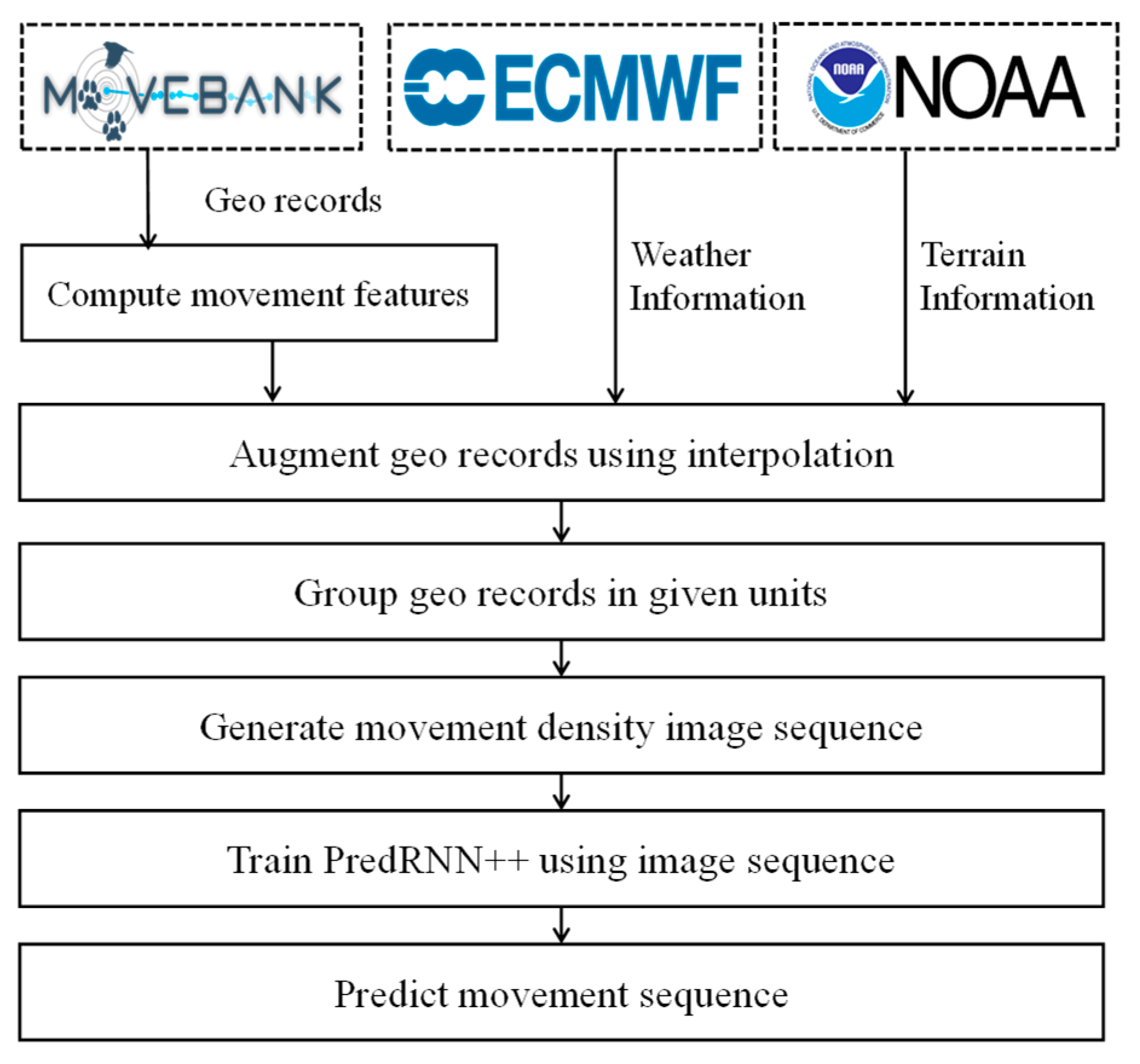
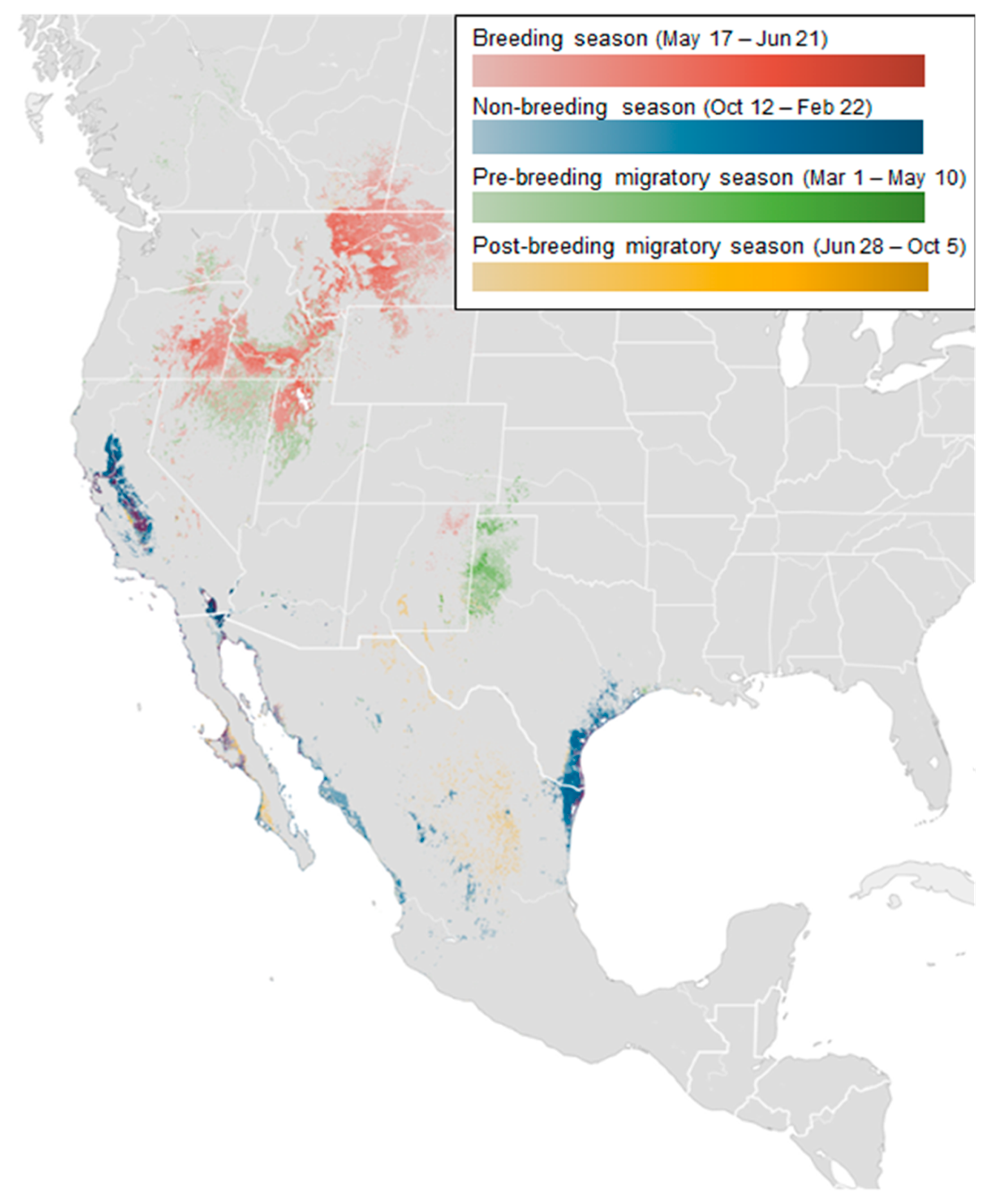
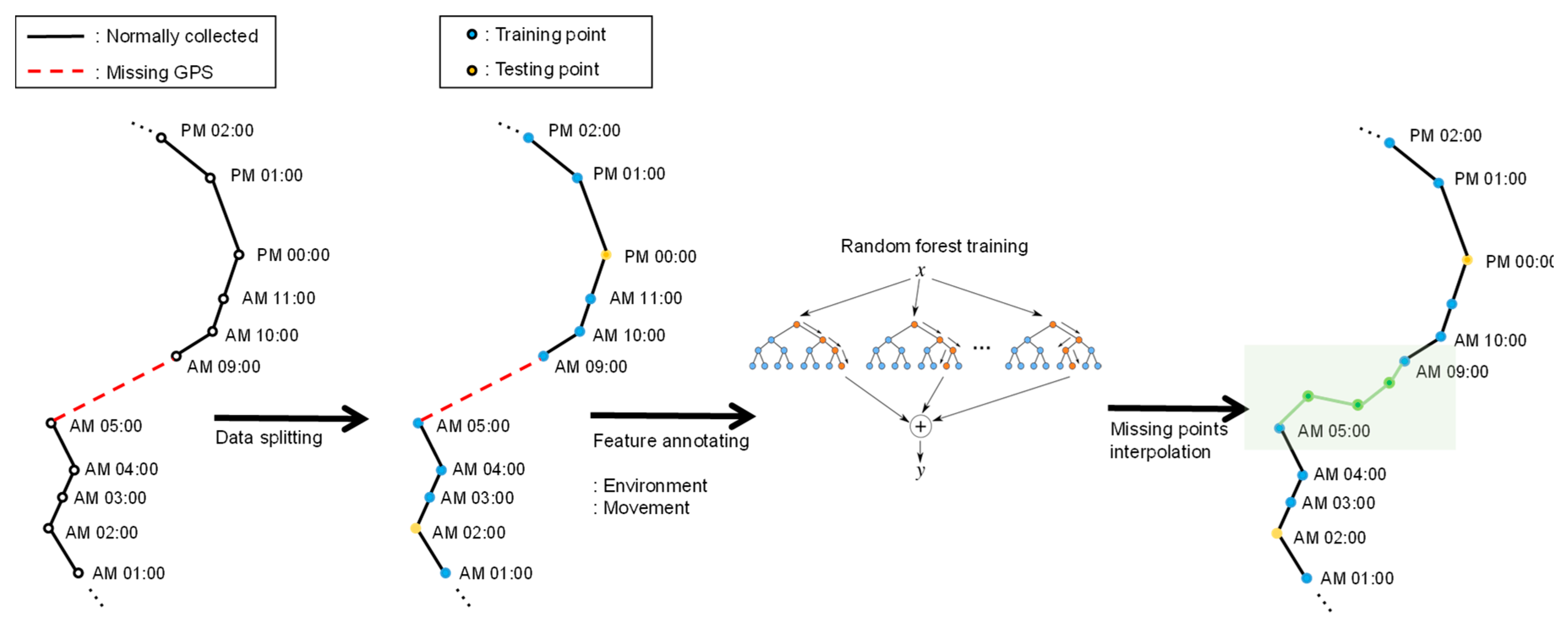


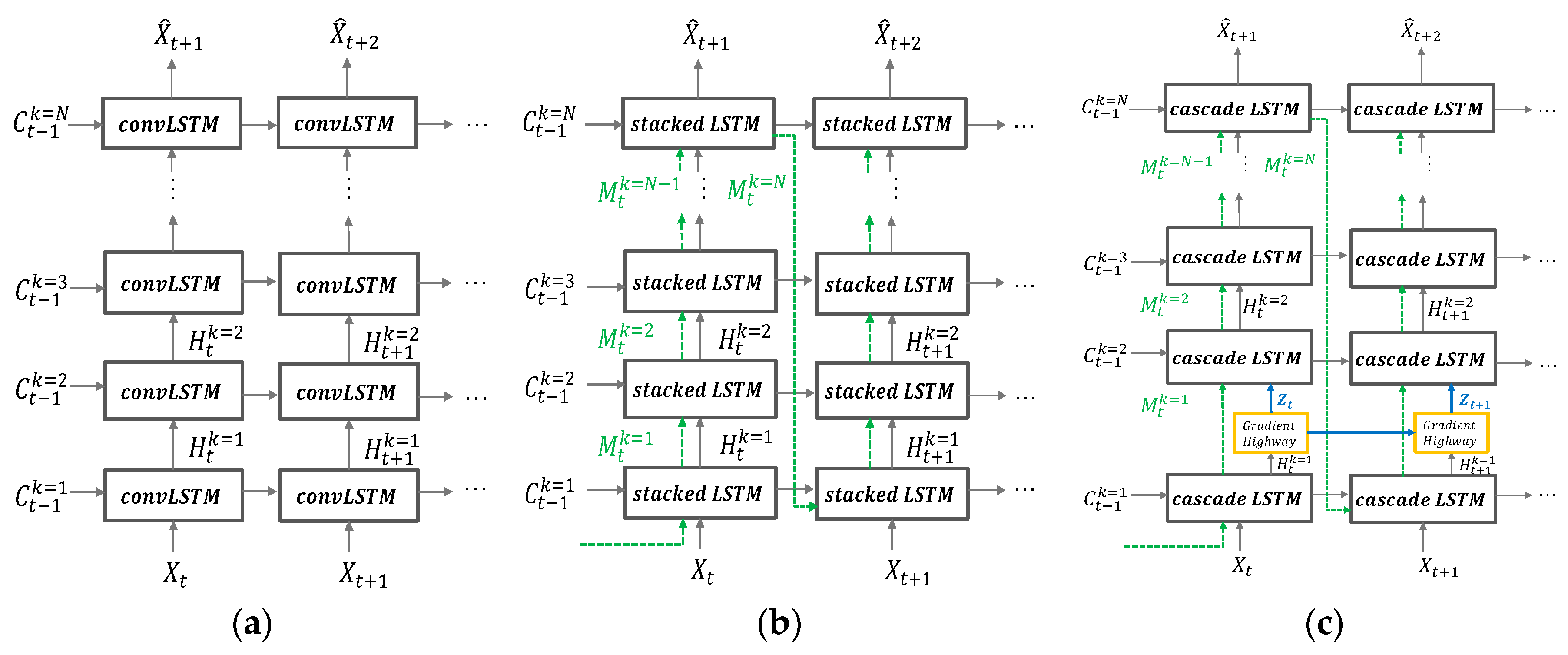

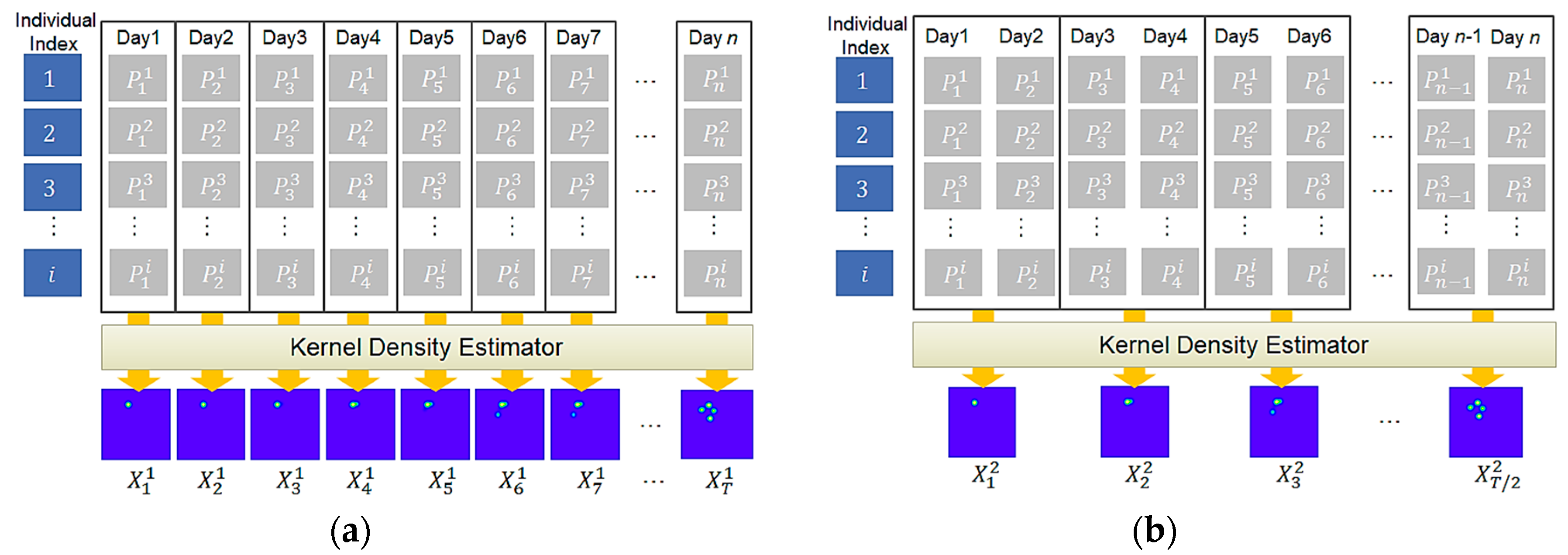

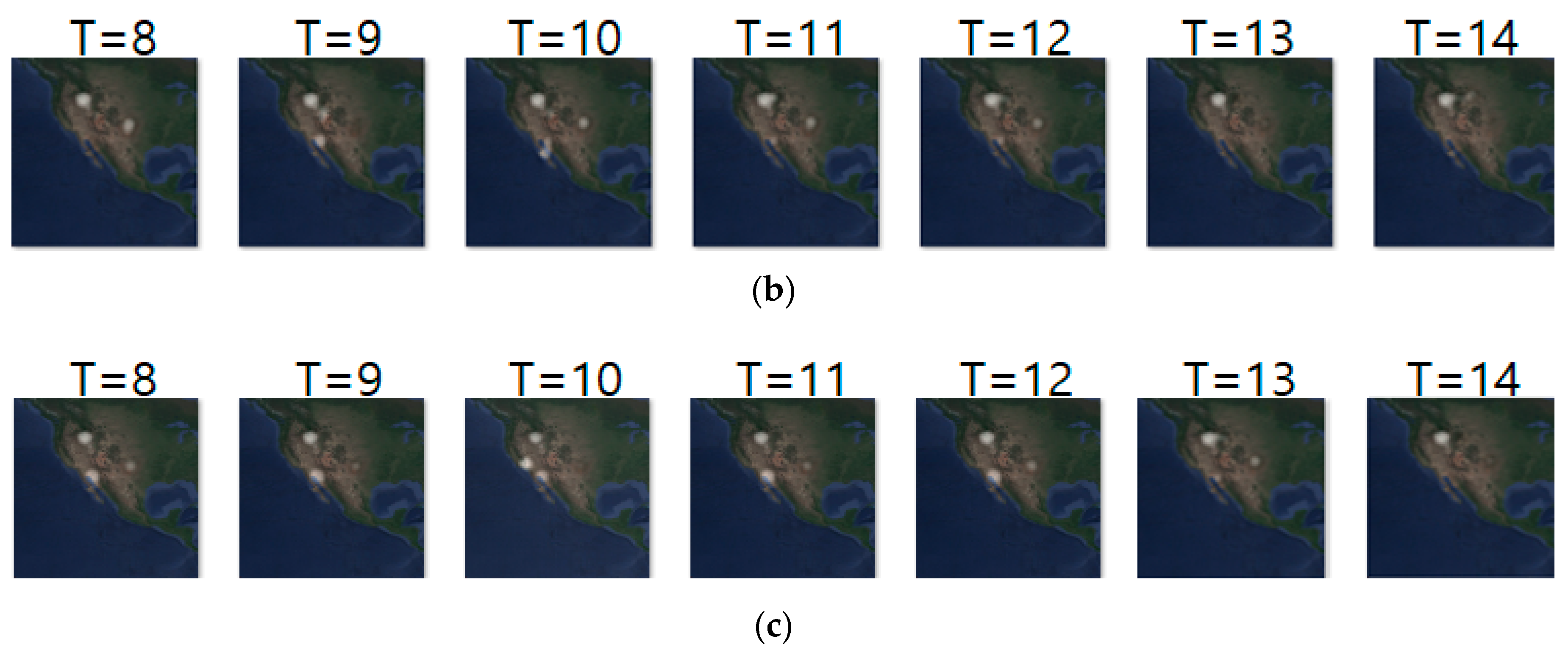
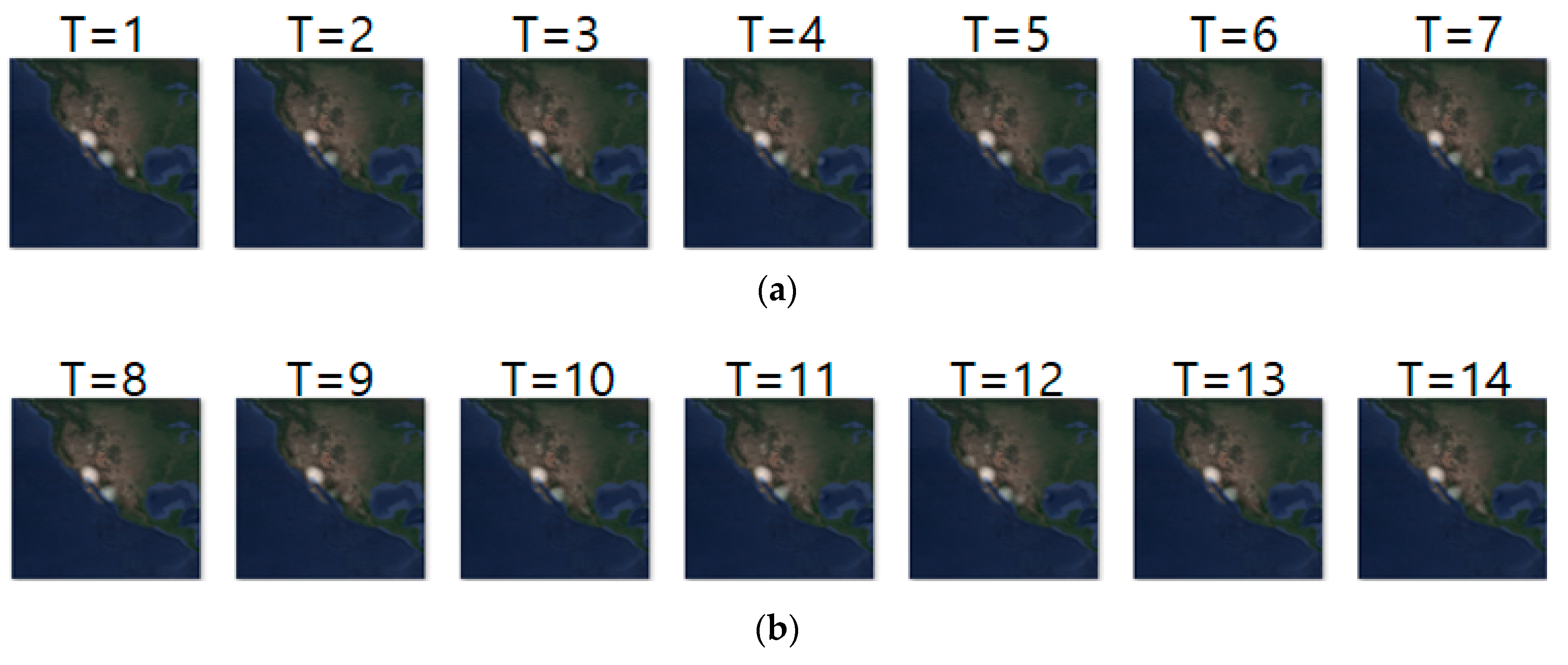

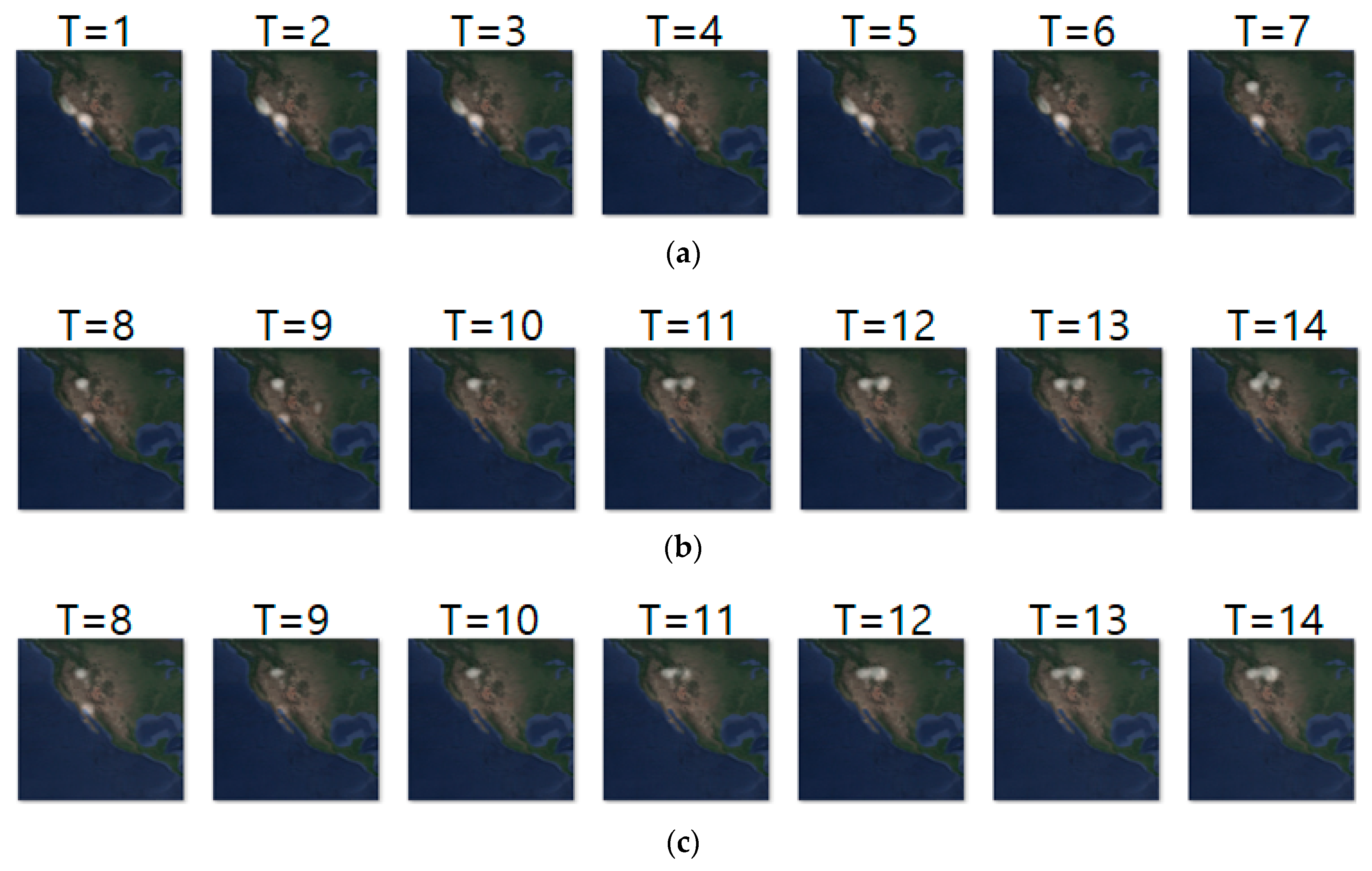
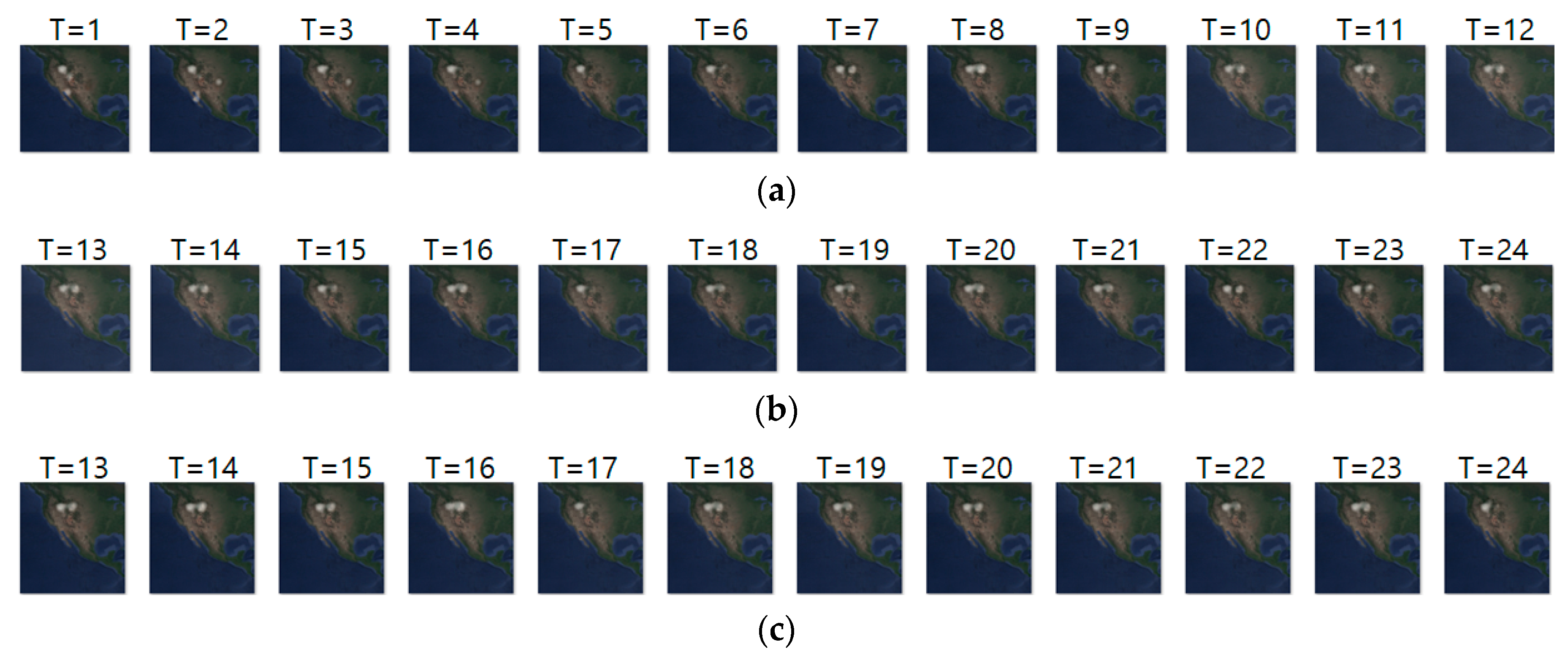
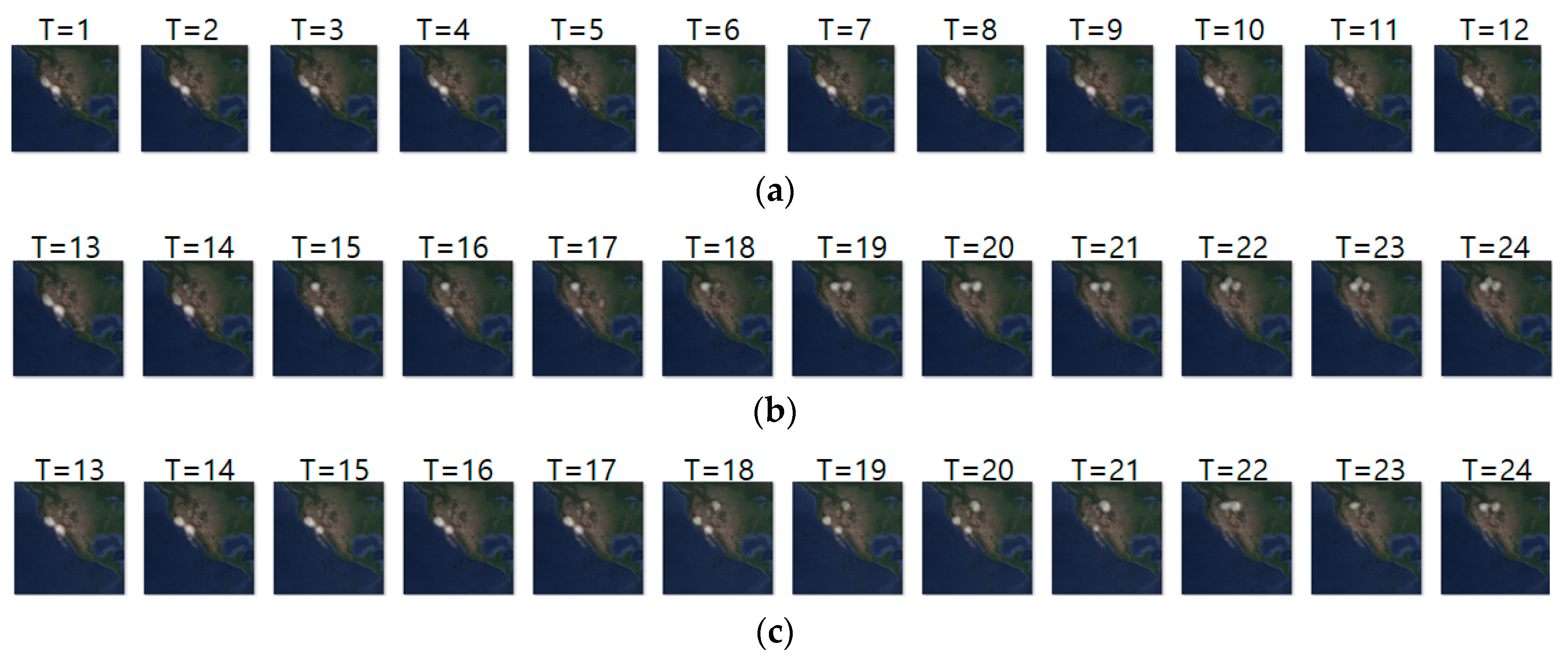
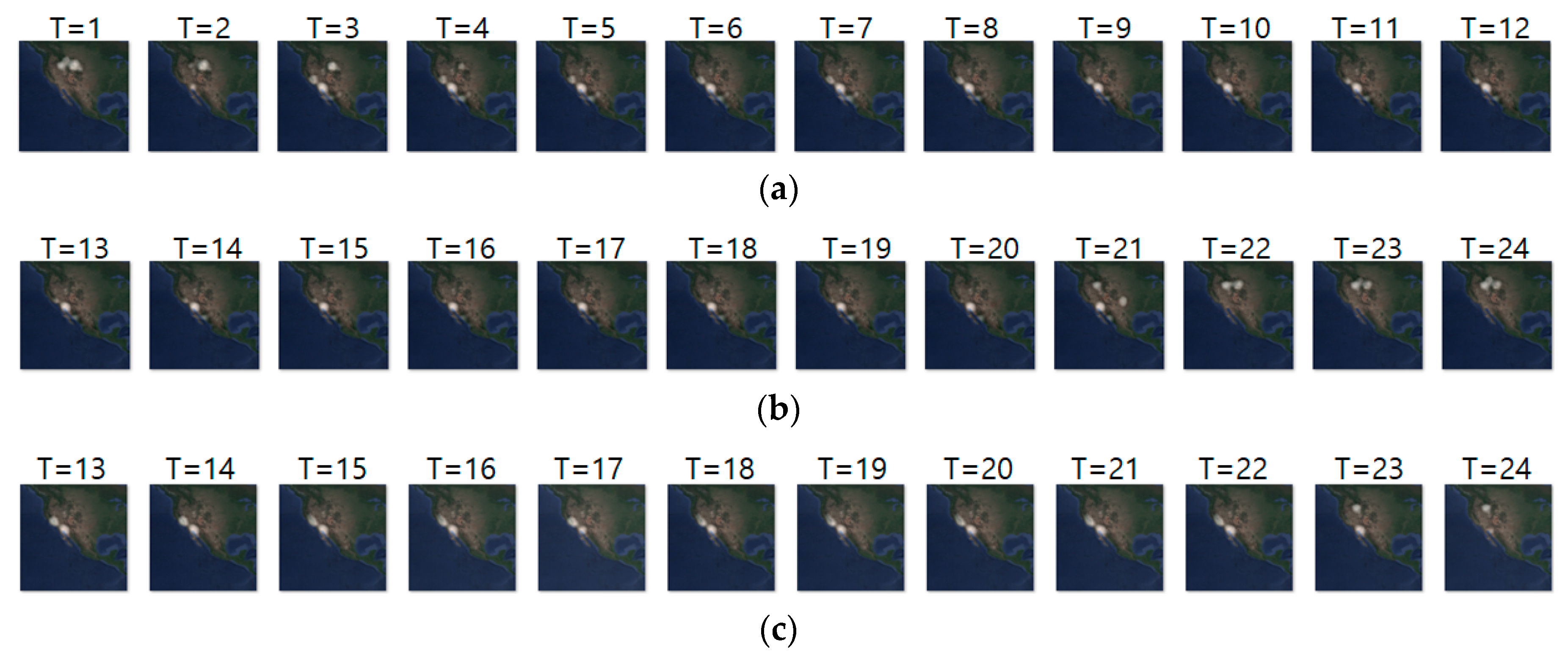
| Interpolation Method | Advantages | Disadvantages | Reference(s) |
|---|---|---|---|
| Linear | Quick calculation No overshooting No undulation | Inaccurate interpolation (Non-linear movement) | Wentz et al. [30] (2003) |
| Cubic spline | Stable Less computation | Overshooting problem | Yu et al. [31] (2003) |
| Polynomial | Simple calculation | Expensive computing Undulation problem | Tremblay [32] (2005) |
| Bezier | Simple calculation Effective interpolation (Non-linear movement) | Sampling points decision problem | Tremblay [32] (2005) |
| Kinematic | Effective interpolation (Fast-moving or linear movement) | Inaccurate interpolation (Large spatial movement) | Long [33] (2016) |
| Prediction Cases | No. of Days to Group Geo Records | No. of Input Images | No. of Predicted Images |
|---|---|---|---|
| Case 1 | 1 | 7 | 7 |
| Case 2 | 2 | 7 | 7 |
| Case 3 | 3 | 7 | 7 |
| Case 4 | 7 | 7 | 7 |
| Case 5 | 15 | 7 | 7 |
| Case 6 | 1 | 12 | 12 |
| Case 7 | 2 | 12 | 12 |
| Case 8 | 3 | 12 | 12 |
| Case 9 | 7 | 12 | 12 |
| Case 10 | 15 | 12 | 12 |
| Interpolation Case # | MAPE (longitude) | ||||
|---|---|---|---|---|---|
| Linear | Bezier | Cubic Spline | Kinematic | Random Forest | |
| Individual #1 | 0.025 | 0.052 | 0.030 | 0.715 | 0.030 |
| Individual #2 | 0.044 | 0.038 | 0.063 | 0.684 | 0.040 |
| Individual #3 | 0.010 | 0.011 | 0.012 | 0.689 | 0.002 |
| Individual #4 | 0.038 | 0.095 | 0.048 | 0.744 | 0.159 |
| Individual #5 | 0.058 | 0.101 | 0.067 | 0.713 | 0.01 |
| Individual #6 | 0.035 | 0.085 | 0.061 | 0.752 | 0.032 |
| Individual #7 | 0.017 | 0.036 | 0.019 | 0.699 | 0.001 |
| Individual #8 | 0.030 | 0.177 | 0.049 | 0.699 | 0.008 |
| Individual #9 | 0.010 | 0.038 | 0.012 | 0.732 | 0.006 |
| Individual #10 | 0.042 | 0.039 | 0.052 | 0.714 | 0.013 |
| Individual #11 | 0.031 | 0.067 | 0.049 | 0.736 | 0.005 |
| Individual #12 | 0.035 | 0.034 | 0.042 | 0.746 | 0.012 |
| Individual #13 | 0.066 | 0.086 | 0.103 | 0.768 | 0.076 |
| Individual #14 | 0.044 | 0.040 | 0.057 | 0.776 | 0.034 |
| Individual #15 | 0.010 | 0.027 | 0.019 | 0.835 | 0.016 |
| Avg. | 0.033 | 0.062 | 0.046 | 0.733 | 0.030 |
| Interpolation Case # | MAPE (latitude) | ||||
|---|---|---|---|---|---|
| Linear | Bezier | Cubic Spline | Kinematic | Random Forest | |
| Individual #1 | 0.132 | 0.462 | 0.177 | 2.449 | 0.180 |
| Individual #2 | 0.082 | 0.132 | 0.118 | 2.088 | 0.181 |
| Individual #3 | 0.049 | 0.038 | 0.059 | 2.519 | 0.026 |
| Individual #4 | 0.256 | 0.302 | 0.263 | 2.946 | 0.179 |
| Individual #5 | 0.246 | 0.453 | 0.303 | 2.315 | 0.231 |
| Individual #6 | 0.145 | 0.686 | 0.377 | 2.592 | 0.301 |
| Individual #7 | 0.051 | 0.130 | 0.068 | 2.517 | 0.065 |
| Individual #8 | 0.068 | 1.275 | 0.228 | 2.439 | 0.124 |
| Individual #9 | 0.019 | 0.263 | 0.044 | 2.762 | 0.046 |
| Individual #10 | 0.235 | 0.150 | 0.253 | 2.368 | 0.159 |
| Individual #11 | 0.070 | 0.148 | 0.136 | 2.974 | 0.047 |
| Individual #12 | 0.084 | 0.125 | 0.136 | 2.714 | 0.102 |
| Individual #13 | 0.393 | 0.487 | 0.701 | 3.209 | 0.254 |
| Individual #14 | 0.153 | 0.076 | 0.164 | 2.537 | 0.048 |
| Individual #15 | 0.043 | 0.070 | 0.086 | 2.889 | 0.052 |
| Avg. | 0.135 | 0.320 | 0.207 | 2.621 | 0.133 |
| Interpolation Case # | RMSE (longitude) | ||||
|---|---|---|---|---|---|
| Linear | Bezier | Cubic Spline | Kinematic | Random Forest | |
| Individual #1 | 0.067 | 0.230 | 0.087 | 0.880 | 0.106 |
| Individual #2 | 0.115 | 0.081 | 0.156 | 0.854 | 0.094 |
| Individual #3 | 0.024 | 0.016 | 0.024 | 0.815 | 0.003 |
| Individual #4 | 0.188 | 0.455 | 0.144 | 0.828 | 0.465 |
| Individual #5 | 0.270 | 0.511 | 0.271 | 0.916 | 0.022 |
| Individual #6 | 0.158 | 0.280 | 0.192 | 0.818 | 0.352 |
| Individual #7 | 0.028 | 0.054 | 0.033 | 0.826 | 0.003 |
| Individual #8 | 0.063 | 0.725 | 0.140 | 0.832 | 0.030 |
| Individual #9 | 0.025 | 0.243 | 0.029 | 0.865 | 0.021 |
| Individual #10 | 0.188 | 0.070 | 0.191 | 0.896 | 0.024 |
| Individual #11 | 0.048 | 0.110 | 0.074 | 0.824 | 0.007 |
| Individual #12 | 0.130 | 0.062 | 0.123 | 0.966 | 0.035 |
| Individual #13 | 0.287 | 0.293 | 0.328 | 0.843 | 0.256 |
| Individual #14 | 0.105 | 0.091 | 0.158 | 0.971 | 0.104 |
| Individual #15 | 0.018 | 0.048 | 0.038 | 1.008 | 0.048 |
| Avg. | 0.114 | 0.218 | 0.133 | 0.876 | 0.105 |
| Interpolation Case # | RMSE (latitude) | ||||
|---|---|---|---|---|---|
| Linear | Bezier | Cubic Spline | Kinematic | Random Forest | |
| Individual #1 | 0.233 | 0.821 | 0.273 | 0.932 | 0.385 |
| Individual #2 | 0.078 | 0.178 | 0.104 | 0.866 | 0.199 |
| Individual #3 | 0.078 | 0.017 | 0.068 | 0.811 | 0.012 |
| Individual #4 | 0.462 | 0.503 | 0.33 | 0.914 | 0.283 |
| Individual #5 | 0.430 | 0.745 | 0.464 | 1.054 | 0.224 |
| Individual #6 | 0.243 | 0.872 | 0.392 | 0.859 | 0.566 |
| Individual #7 | 0.023 | 0.053 | 0.033 | 0.825 | 0.040 |
| Individual #8 | 0.047 | 1.799 | 0.308 | 0.859 | 0.205 |
| Individual #9 | 0.012 | 0.729 | 0.078 | 0.863 | 0.127 |
| Individual #10 | 0.548 | 0.074 | 0.549 | 0.978 | 0.136 |
| Individual #11 | 0.027 | 0.072 | 0.107 | 0.926 | 0.018 |
| Individual #12 | 0.054 | 0.073 | 0.105 | 1.407 | 0.085 |
| Individual #13 | 0.493 | 0.437 | 0.574 | 0.913 | 0.278 |
| Individual #14 | 0.317 | 0.046 | 0.244 | 0.923 | 0.036 |
| Individual #15 | 0.022 | 0.038 | 0.052 | 0.923 | 0.064 |
| Avg. | 0.204 | 0.430 | 0.245 | 0.937 | 0.177 |
| Evaluation Metrics | |||||
| Avg. MSE | Avg. RMSE | Avg. SSIM | Avg. Centroid Distance (in pixels) | Avg. Centroid Distance (in km) | |
| Case 1 | 44.236 | 6.651 | 0.970 | 4.583 | 110.179 |
| Case 2 | 44.571 | 6.676 | 0.965 | 5.299 | 127.413 |
| Case 3 | 51.090 | 7.148 | 0.963 | 5.586 | 134.299 |
| Case 4 | 58.142 | 7.625 | 0.958 | 7.028 | 168.983 |
| Case 5 | 72.445 | 8.511 | 0.937 | 8.492 | 204.182 |
| Case 6 | 43.445 | 6.591 | 0.968 | 4.698 | 112.944 |
| Case 7 | 43.182 | 6.571 | 0.962 | 5.037 | 121.099 |
| Case 8 | 53.219 | 7.295 | 0.953 | 5.487 | 131.933 |
| Case 9 | 62.847 | 7.928 | 0.943 | 7.602 | 182.779 |
| Case 10 | 142.449 | 11.935 | 0.932 | 10.265 | 246.795 |
| Evaluation Metrics | |||
|---|---|---|---|
| RMSE (in Centroid Pixel) | Avg. Centroid Distance (in pixels) | Avg. Centroid Distance (in km) | |
| Case 1 | 6.872 | 4.583 | 110.179 |
| Case 6 | 6.914 | 4.698 | 112.944 |
| VAR | 10.573 | 12.840 | 308.695 |
| Evaluation Metrics | |||
|---|---|---|---|
| RMSE (in Centroid Pixel) | Avg. Centroid Distance (in pixels) | Avg. Centroid Distance (in km) | |
| Case 4 | 7.885 | 7.328 | 176.191 |
| Case 9 | 8.021 | 7.602 | 182.779 |
| VAR | 9.075 | 11.0211 | 264.957 |
| Evaluation Metrics | |||
|---|---|---|---|
| RMSE (in Centroid Pixel) | Avg. Centroid Distance (in pixels) | Avg. Centroid Distance (in km) | |
| Case 5 | 8.846 | 8.492 | 204.182 |
| Case 10 | 12.513 | 10.265 | 246.795 |
| VAR | 8.857 | 10.757 | 228.606 |
| Metric | Prediction day | ||||||
|---|---|---|---|---|---|---|---|
| 8 | 9 | 10 | 11 | 12 | 13 | 14 | |
| RMSE | 6.913 | 7.816 | 7.491 | 6.622 | 7.337 | 7.719 | 6.532 |
| SSIM | 0.966 | 0.963 | 0.959 | 0.961 | 0.960 | 0.965 | 0.939 |
| Cent-Dist in pixels | 0.970 | 3.240 | 2.509 | 1.360 | 2.126 | 1.761 | 2.809 |
| Cent-Dist in km | 23.331 | 77.901 | 60.333 | 32.700 | 51.121 | 42.334 | 67.526 |
| Metric | Prediction day | ||||||
|---|---|---|---|---|---|---|---|
| 8 | 9 | 10 | 11 | 12 | 13 | 14 | |
| RMSE | 4.803 | 6.484 | 6.166 | 5.390 | 7.190 | 6.112 | 6.942 |
| SSIM | 0.967 | 0.960 | 0.962 | 0.971 | 0.959 | 0.973 | 0.962 |
| Cent-Dist in pixels | 1.833 | 4.342 | 4.047 | 3.647 | 5.603 | 3.085 | 1.833 |
| Cent-Dist in km | 44.067 | 104.385 | 97.315 | 87.694 | 134.723 | 74.167 | 44.067 |
| Prediction day T | |||||||
|---|---|---|---|---|---|---|---|
| 8 | 9 | 10 | 11 | 12 | 13 | 14 | |
| RMSE | 7.243 | 6.949 | 7.042 | 7.735 | 8.240 | 6.286 | 7.904 |
| SSIM | 0.955 | 0.964 | 0.976 | 0.971 | 0.965 | 0.967 | 0.947 |
| Cent-Dist in pixels | 2.777 | 3.135 | 2.749 | 3.799 | 3.475 | 1.642 | 4.182 |
| Cent-Dist in km | 66.777 | 75.379 | 66.104 | 91.344 | 83.544 | 39.483 | 100.552 |
| Prediction day T | ||||||||||||
|---|---|---|---|---|---|---|---|---|---|---|---|---|
| 13 | 14 | 15 | 16 | 17 | 18 | 19 | 20 | 21 | 22 | 23 | 24 | |
| RMSE | 4.16 | 4.18 | 4.77 | 7.90 | 5.08 | 4.35 | 4.49 | 5.82 | 6.18 | 5.62 | 4.83 | 7.16 |
| SSIM | 0.97 | 0.96 | 0.96 | 0.95 | 0.96 | 0.97 | 0.97 | 0.96 | 0.95 | 0.96 | 0.96 | 0.96 |
| Cent-Dist in pixels | 1.5 | 1.8 | 1.5 | 3.6 | 2.2 | 2.3 | 2.4 | 3.4 | 2.1 | 2.2 | 2.5 | 2.4 |
| Cent-Dist in km | 36.7 | 45.5 | 36.9 | 88.8 | 53.2 | 56.1 | 57.7 | 82.9 | 50.8 | 53.1 | 61.6 | 59.3 |
| Prediction day T | ||||||||||||
|---|---|---|---|---|---|---|---|---|---|---|---|---|
| 13 | 14 | 15 | 16 | 17 | 18 | 19 | 20 | 21 | 22 | 23 | 24 | |
| RMSE | 4.54 | 7.98 | 15.64 | 15.11 | 16.36 | 16.27 | 15.36 | 15.49 | 14.37 | 8.39 | 7.67 | 7.06 |
| SSIM | 0.97 | 0.96 | 0.93 | 0.94 | 0.92 | 0.93 | 0.93 | 0.93 | 0.94 | 0.95 | 0.95 | 0.96 |
| Cent-Dist in pixels | 3.6 | 7.0 | 13.7 | 16.4 | 16.1 | 15.9 | 15.7 | 14.1 | 10.4 | 5.7 | 6.2 | 5.4 |
| Cent-Dist in km | 87.7 | 170.2 | 329.6 | 394.5 | 388.5 | 383.7 | 377.9 | 338.9 | 250.0 | 139.2 | 150.8 | 130.3 |
| Prediction day T | ||||||||||||
|---|---|---|---|---|---|---|---|---|---|---|---|---|
| 13 | 14 | 15 | 16 | 17 | 18 | 19 | 20 | 21 | 22 | 23 | 24 | |
| RMSE | 9.80 | 10.55 | 9.41 | 10.10 | 11.57 | 9.39 | 10.51 | 10.45 | 15.43 | 19.18 | 12.82 | 9.91 |
| SSIM | 0.95 | 0.95 | 0.94 | 0.94 | 0.94 | 0.94 | 0.94 | 0.93 | 0.90 | 0.90 | 0.93 | 0.95 |
| Cent-Dist in pixels | 1.4 | 1.6 | 1.9 | 3.6 | 2.9 | 2.7 | 3.4 | 3.8 | 8.3 | 15.5 | 12.2 | 3.2 |
| Cent-Dist in km | 34.1 | 40.5 | 46.7 | 88.2 | 70.3 | 65.0 | 82.7 | 93.4 | 201.7 | 373.8 | 294.7 | 78.21 |
© 2019 by the authors. Licensee MDPI, Basel, Switzerland. This article is an open access article distributed under the terms and conditions of the Creative Commons Attribution (CC BY) license (http://creativecommons.org/licenses/by/4.0/).
Share and Cite
Rew, J.; Park, S.; Cho, Y.; Jung, S.; Hwang, E. Animal Movement Prediction Based on Predictive Recurrent Neural Network. Sensors 2019, 19, 4411. https://doi.org/10.3390/s19204411
Rew J, Park S, Cho Y, Jung S, Hwang E. Animal Movement Prediction Based on Predictive Recurrent Neural Network. Sensors. 2019; 19(20):4411. https://doi.org/10.3390/s19204411
Chicago/Turabian StyleRew, Jehyeok, Sungwoo Park, Yongjang Cho, Seungwon Jung, and Eenjun Hwang. 2019. "Animal Movement Prediction Based on Predictive Recurrent Neural Network" Sensors 19, no. 20: 4411. https://doi.org/10.3390/s19204411
APA StyleRew, J., Park, S., Cho, Y., Jung, S., & Hwang, E. (2019). Animal Movement Prediction Based on Predictive Recurrent Neural Network. Sensors, 19(20), 4411. https://doi.org/10.3390/s19204411






